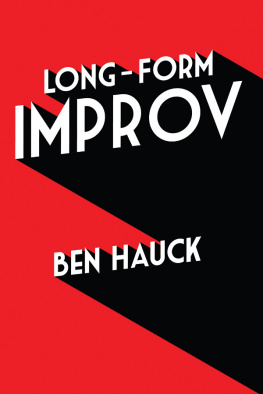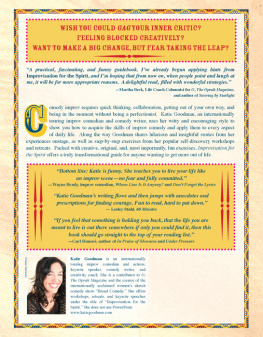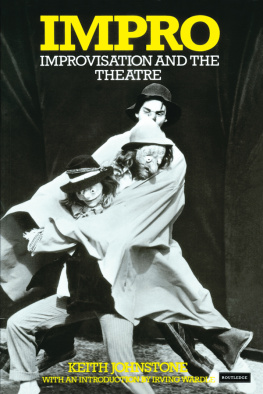Page List
Improvisation
A PRACTICAL GUIDE
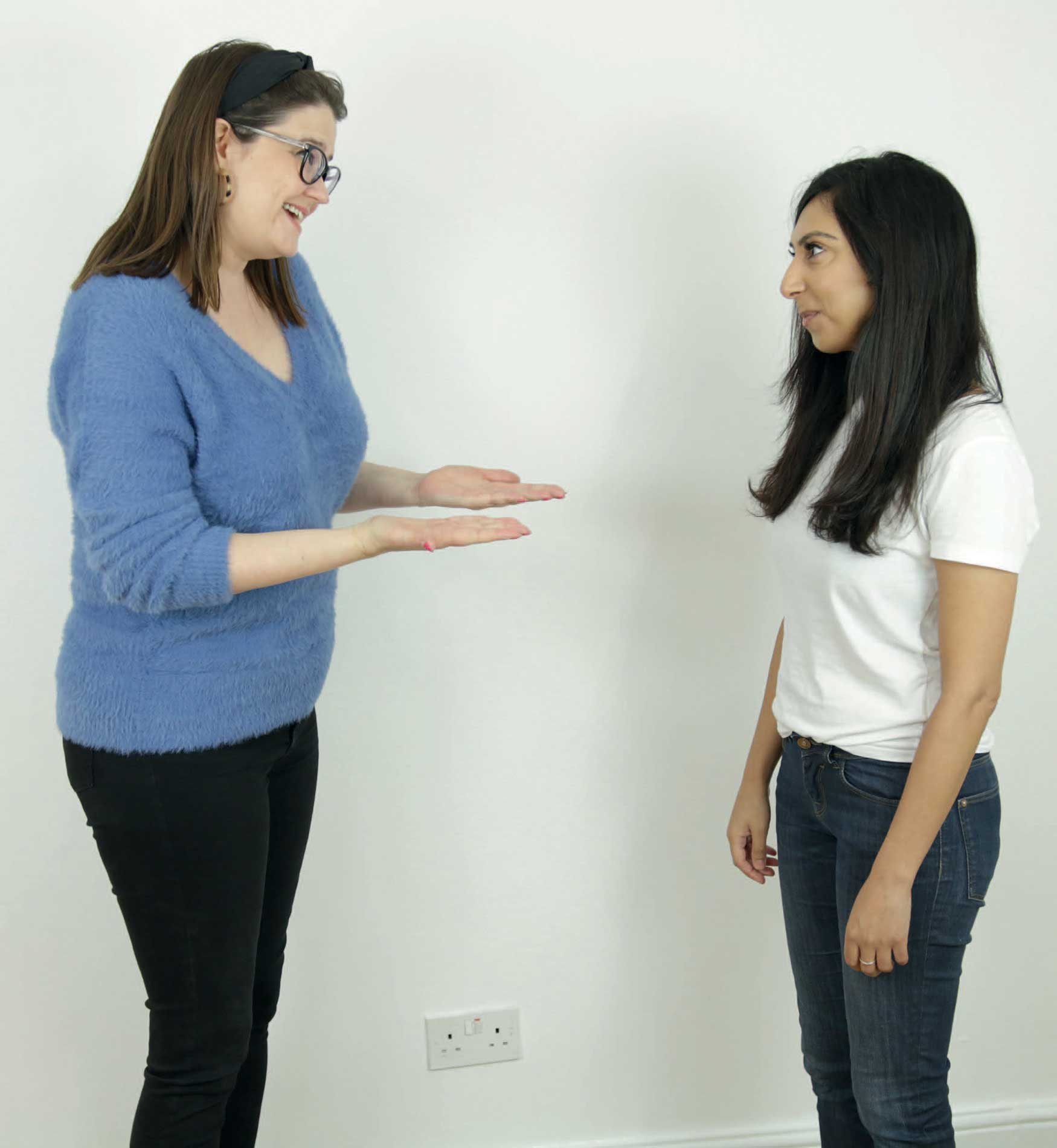
Improvisation
A PRACTICAL GUIDE
Jason Moran

First published in 2021 by
The Crowood Press Ltd
Ramsbury, Marlborough
Wiltshire SN8 2HR
www.crowood.com
This e-book first published in 2021
Jason Moran 2021
All rights reserved. This e-book is copyright material and must not be copied, reproduced, transferred, distributed, leased, licensed or publicly performed or used in any way except as specifically permitted in writing by the publishers, as allowed under the terms and conditions under which it was purchased or as strictly permitted by applicable copyright law. Any unauthorised distribution or use of this text may be a direct infringement of the authors and publishers rights, and those responsible may be liable in law accordingly.
British Library Cataloguing-in-Publication Data
A catalogue record for this book is available from the British Library.
ISBN 978 1 78500 932 7
Disclaimer
Every reasonable effort has been made to trace and credit copyright holders. In the event of an omission, please contact the publisher, who will be pleased to add a credit in any future edition.
ACKNOWLEDGEMENTS
I would like to thank the Viola Spolin estate, specifically Aretha Sills and Carol Sills, for their support on the history of improvisation, and to Bloomsbury Publishing for their support with the same subject matter.
I must say a big thank you to all the great improvisers that have come and gone before us, and to the teachers and performers I have met over the years.
Id like to thank my mother, Colette Moran, and my aunt, Vera Wegner, for their support and input on the human side of improvisation, and its benefits around mental health specifically, and to my partner, Alexis Moore, for keeping me motivated throughout.
Also, thank you to Jake Lyons for his friendship and mentorship over the years; indeed thanks go to all the Livewired comedy improvisation troupe (hereafter referred to simply as Livewired) and its community, past and present, as well as the London Improv Theatre.
Special thanks go to Jonathan for his diligence and research on the history of improvisation, and to Pali for her input in this text. (Both made appearances in the illustrations, along with Emma; other actors appearing are Tom, Katie and Paul from Livewired.) A final big thanks goes to Andrei for photographing the images.
Photo and illustrations: Andrei Avram.
Actors: Jonathan Reed, Pali Jhita, Emma Birkett, Tom Lovegrove, Katie Colley and Paul Whyman.
History of Improvisation: compiled by Jonathan Reed.
The Dark Side of Improv: written by Pali Jhita.
Improvisation and Mental Health Colette Moran BA and Vera Wegner MACBT, MIACP.
PREFACE
The one thing we all have in common is the unknown: whats going to happen next? As children we knew no different we relied on the people around us to guide us through our early life, our parents, siblings, grandparents, cousins, teachers, friends, schools and community. Life was joyous, and everything we did we wanted to do right, we wanted to aspire and to learn. For some it was academic to read, study, or be good at maths for others it was sport, while yet others loved the manual work that occupied their parents, such as farming or working with machinery, tailoring or working as a seamstress, or cooking and baking. It didnt matter, there was something in all of us that drove that early passion and joy of learning something new. But at some point the unknown became scary and made us feel unstable, and as creatures of habit we built ourselves a routine to make our lives predictable and keep us feeling safe.
My acting journey started early in life, when as a child I went to a local speech and drama class: something about it made me feel at home. I wasnt a good footballer, nor was I particularly cool or popular, but in this class I felt as if I had found my place. This feeling never left me, and as I grew into adulthood I continued to enjoy and train in theatre and acting.
As an actor I loved the predictability, routine and ceremony of performing in a play: arriving at the theatre at the same time each evening, having a snack and a pre-show shower, then the application of make-up and costume, and lastly a light warm-up before going on stage. This routine made me feel safe, and it became part of the ceremony in preparing for the show and if one item in this routine was left out it had a knock-on effect that rippled through the entire performance of the play on that occasion.
Improvisation to me then was a simple tool I would use if I forgot or miscued my lines, or if a fellow actor forgot their lines: then one of us would wing it and improvise lines to get us back on track. It is also a common practice of many directors to use improvisation as a rehearsal mechanism while we work out our characters. I have used this technique myself with actors whom I have directed, and I still do.
In truth I never appreciated the full depth of this art form until I randomly walked into an improv class and there it began. In that room on that day were a few other actors like me, looking to take a short course and thereby strengthen a skill long forgotten since drama school. There were also marketeers, advertising producers, dancers, stand-up comedians, people looking to improve their confidence and public-speaking skills, and some just looking to have fun.
All of us were uncertain, nervous and excited. We were already sharing the magic of improvisation before the class even started, and what happened with us over the next weeks, months and years I have seen happen hundreds of times since with the groups I have taught, coached and directed. A bond formed that none of us ever forgot.
To this day I am still in touch with most of those in that first improvisation class. I have carried on doing acting projects with some of these people, while others I have trained and worked with as we continued our improv journey and training.
Some of us have continued our careers as actors, comedians, teachers, while others have moved to direction, production, dance, music and the people not involved in performance arts have continued to use their improvisation training in their worlds of advertising production or as corporate facilitators or trainers. When we reunite once a year or so we can still remember our first improvised scenes with each other, and the joy we shared all those years ago.
What tends to fascinate people most when watching improv, especially for the first time, is the idea that a structured story with rounded characters can be made up, right there on the spot and with no preparation. I can remember myself as a young teenager watching Whose Line Is It Anyway? in both the US and UK versions, doubting the authenticity of the show, wondering if the actors really were making it up, thinking they must have had a tip-off before the show, or been given a template to work from. This couldnt be real. Even my mother, who has spent a lot of time also treading the boards, had some degree of doubt.
How wrong I was! Once the skills of improvisation were explained and taught to me, and I began to apply them in improvised scene building, my view began to change. I even came to a point where Id prefer to improvise completely instead of working from a script. And as you can imagine, this is a complete turnaround for someone whose initial training was traditional acting.

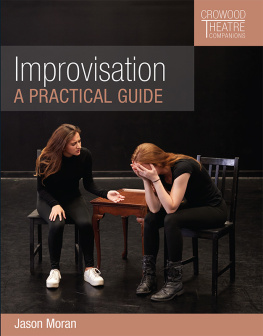

![Viola Spolin - Improvisation for the Theater: A Handbook of Teaching and Directing Techniques [1963 ed.]](/uploads/posts/book/406435/thumbs/viola-spolin-improvisation-for-the-theater-a.jpg)
